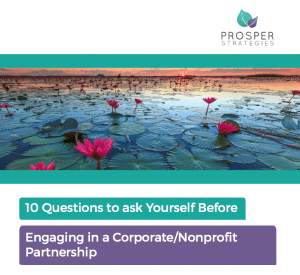At Prosper, we work with nonprofits and for-profit social impact companies every day, and we’re all about supporting the organizations that put impact first. But B Corps and other social impact organizations can’t do it alone. There’s a role for other types of companies to play as well.
Since the March of Dimes and Marriott Hotels introduced their partnership back in the 1970s, more and more nonprofits and for-profits have begun to recognize the power of corporate-nonprofit partnerships. Originally called “cause marketing” (and still called that by some) these partnerships have evolved to be about far more than just marketing and brand awareness.
“Cause marketing” may be a handy term for these partnerships, but it can also minimize the measurable impact that both partners aim to achieve. And corporate-nonprofit partnerships can raise significant funds for critical causes. Just look at Patagonia, which last year promised to donate 100% of its Black Friday sales to environmental causes, and ended up raising $10 million — five times its projected sales for the day.
Let’s take a look at two other corporations that are using their resources to do good — and how they talk about it in their marketing.
Target: Nonprofit Partnerships at the Local Level
Target has a national presence, but has committed to making a local impact through its nonprofit partnerships. Here in Chicago, local Target stores have partnered with nonprofits including the National Museum of Mexican Art and the United Way of Metro Chicago. In 2016, Target gave back to Chicago through 40,000 volunteer-hours with local nonprofits, 2.7 million pounds of food donated through food bank partners and $10.8 million in donations.
Marketing did play a role in these partnerships, in a way that benefits both Target and their partners. Take a look at this mobile ad.
In the interactive ad, Target highlights the locations of each local nonprofit it works with. The viewer can click on each one to see more detail about their work in the community. These ads have a Target-sized budget to boost awareness of each of the nonprofits, and they show Target’s commitment to local organizations.
If you work for a local nonprofit and are looking for a corporate partner, these ads tell you one more thing: that you shouldn’t be intimidated by national brands. Especially in the digital era, these companies may be looking for ways to form concrete, offline connections to communities. These connections don’t just have to be about selling more stuff. If you know of a business that you feel shares your values and could align with your goals, approach them with an idea.
[bctt tweet=”If your nonprofit is looking to partner with a corporation, don’t be intimated national brands.” username=”ProsperStrat”]Southwest: Nonprofit Partnerships Based on a Core Service
Since 2007, Southwest Airlines has provided free medical transportation to patients and caregivers. The airline works with four medical charities: Angel Flight Central, Mercy Medical Angels, Miracle Flights for Kids and Patient Airlift Services; and nonprofit hospitals in 27 states and Washington, D.C. Over the past decade, the airline has donated the equivalent of over $23.6 million in free transportation.
Southwest’s nonprofit partnerships are closely tied to its core service: taking people where they need to go. The company is in a unique position to serve its nonprofit partners because it is one of the four largest airlines based in the U.S.
Southwest’s medical transportation work isn’t something they splash on every banner and billboard. It’s featured on their website on the “Southwest Citizenship” page. Since Southwest’s donations to the program come in the form of flights and pilot-hours, the nonprofits involved are not necessarily looking for an awareness campaign from the program. They’re looking for Southwest to continue to give directly.
When Southwest does highlight their nonprofit partnerships, mainly on social media, they present them as one part of their commitment to being an airline that cares about people, not just profits. This video tells the story of Wrenn, who must fly to St. Louis Children’s Hospital once every six months to receive treatment for a lung condition.
Southwest’s partnerships show why “cause marketing” is not necessarily the right term for the corporate-nonprofit partnerships making a difference today. These stories are shared in Southwest’s digital marketing, but awareness is only one part of the goal. The real impact is felt by the families who receive the free flights that allow them life-saving treatment. If that’s the type of partnership your nonprofit is looking for, there are companies willing to work with you. When you work with a for-profit to determine the terms of a partnership, how those stories will be told and used in marketing is one thing to discuss. Working together, you can shape a strategy that tells the story you want to tell to their audience.
If your nonprofit is interested in finding a corporate partner, start by hammering out an idea of what you’re looking for in a partnership. Are you looking for a source of funds or in-kind donations? Or do you chiefly need a larger pool of volunteers? Is building awareness locally or nationally a component of your plan? Once you have a sense of what you want in your corporate-nonprofit partnership, you can begin reaching out to companies.
 With the right partner by your side, you have the opportunity to greatly expand your impact.
With the right partner by your side, you have the opportunity to greatly expand your impact.
Before you get started finding a corporate partner, you have to ask the right questions. Our resource lists the 10 questions you should ask yourself before partnering up with another organization.
Download this resource to find out if you’re ready to engage in a corporate partnership.


